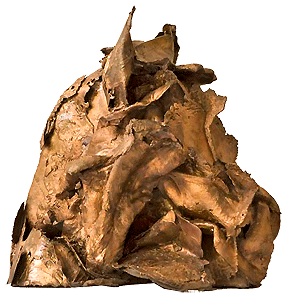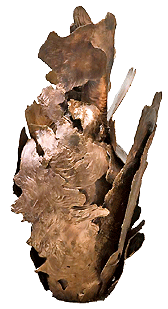- Prelude
- Editorial
- 'Public Sculptures are the Public's own Consciousness'
- Stimulating Thoughts
- Sculptural Traditions and Contemporary Art Practices
- Sculpting out a Third Dimension from Madhya Pradesh
- About Nostalgic Dragonflies and Homes in the Bags: Sculptural Snapshots from the North-East
- A Concise Chronicle of Bengal's Modern Sculpture
- Neo-sculptural Identity: Six Young Sculptors
- From Object to Experience: Notes on American Sculpture
- In the Domain of Drama Sculptures of S.Nandagopal
- Satish Gujral : Sculpting the Inner Form
- Transformation of Articulations: Mrinalini Mukherjee
- The Experiential Quotient in the Sculptures of Ravinder Reddy
- Shresta Rit Premnath A Passion for Structure
- The Anatomy of Melancholy: Sculptures of Rajesh P Subramanium
- A Crusader of/for Site Specific Public Art: Subodh Kerkar
- Installation Practices in and around Santiniketan
- A Wall is a Screen: A Promenade Film Street Performance
- Jaeger-LeCoultre An Overview
- Regency Style: Regency Furniture
- Designing the Streetscapes: Visual Elements of Pedestrian Corridors
- Sculpture Rules It All
- The Triumph of the Eternal
- Artist Index and Statistics- Anish Kapoor
- Auction Reports
- Musings from Chennai
- Art Bengaluru
- Art Events Kolkata: October-November 2010
- Mumbai Art Sighting
- An Evening of Interaction
- 6th Asian Museum Curators' Conference
- Swedish Art in India
- Couple of Difference : Recent sculptures of Karl Antao
- Previews
- In the News
- Sotheby's : Important Watches Geneva
ART news & views
Transformation of Articulations: Mrinalini Mukherjee
Volume: 3 Issue No: 11 Month: 12 Year: 2010
by Mansi Dhiman
Elocution/ articulations always have different meanings but it matters most when it comes to articulating the chain of thoughts through a three dimensional form portraying the artist's creative expression, in order to make a statement.. It often comes through the personal and sensory experiences.. Accepting reactions as means of visual creations also can be considered as the responsibility of an artist to depict what s/he sees around, and the changes happening in the society. The process of receiving or grasping ideas may not necessarily be unilinear.. Reactions are the chain of events that are unfolded through the human forms/non-human forms that are three-dimensional, which gains tremendous power of expression as it becomes an easy process for the sensory perception to understand articulations having self-generated meanings.. A three-dimensional medium, such as . sculpture, is in itself is very powerful medium but it becomes even more powerful when it is used for articulating the thoughts of a veteran artist like Mrinalini Mukherjee.. An artist of rare bequest and sensitivity.  who has her own visual language of art form, and still is creating new visuals., Mrinalini has in her own accord made a place among the greatest Indian artists.
who has her own visual language of art form, and still is creating new visuals., Mrinalini has in her own accord made a place among the greatest Indian artists.
Born in Mumbai in 1949 into a surrounding of art Mrinalini is the only daughter of the renowned artist Benode Behari and Leela Mukherjee.. She studied painting from the Faculty of Fine Art, M.S. University of Baroda and later studied mural designing under artists like K.G. Subramanyan, receiving a Post-Diploma in the same. Studying art would have been just like enthralling legacy from her parents. Mrinalini belongs to the group of Indian artists, who have contributed in shaping contemporary Indian art..
As an artist who has seen a long way of changing styles, isms, transitions from traditional to modern, dimensions and meanings in the history of Indian art, Mrinalini. has also witnessed art growing and developing in her own surroundings. This has led her to cultivate herself as a professional artist, creating a style of her own, which is rooted in her personality and environment. By creating a new visual language, the artist communicates her artistic abundance, wrought with power and energy. Mrinalini's works relate inevitably to her Indian origins and experiences, the affinities with the astonishing craft practices of our country, the spontaneous dialogue between high art and colloquial speech sources.
The sculptor has been experimenting with the visual vocabulary as well as with the medium of her works since early years of her career..  Her work has from acquired inspiration from the surroundings she lived in and experiences of her life. Scrutinizing the imagery of Mrinalin's sculptures one can easily analyze, ascertain and interpret a gradual process of augmentation, in the context of visual vocabulary and medium.. The early works of Mrinalini were a response towards the town she was living in, towards the vegetation and the flora. Leisurely, the process of augmentation started when the biomorphic elements enlivened the plant forms and the interplay of planes/surface tension grew more intricate as well as multifaceted and acquired the recognizable body.
Her work has from acquired inspiration from the surroundings she lived in and experiences of her life. Scrutinizing the imagery of Mrinalin's sculptures one can easily analyze, ascertain and interpret a gradual process of augmentation, in the context of visual vocabulary and medium.. The early works of Mrinalini were a response towards the town she was living in, towards the vegetation and the flora. Leisurely, the process of augmentation started when the biomorphic elements enlivened the plant forms and the interplay of planes/surface tension grew more intricate as well as multifaceted and acquired the recognizable body.
The transitions sometimes show the most sensitive and vigorous facets of an artist. The images she deploys create an illusion of being human as well as plant, underscoring the unity between flora and human body. They show that she is not only showing her love and affection towards the nature but also questioning the relationship between man and nature and responding to it.. There was a time when the transition period came at its end, and maturity which gave a different form to the imagery, the iconic figures started emerging with the concave and convex curves of the three-dimensionality. The transformation in the imagery is also there, slowly these figures transform into a semi-abstract and then into an absolute abstract form. Abstract forms/visuals have different levels of text and sub-text within, which sometimes work as the hidden quality of the works. The hidden qualities even give a strong note on sexuality in Mrinalini's works. There is a sensuous, tactile quality in her work which exercises a compelling hold on the viewer.
There are many more aspects of a three-dimensional visual which also include the surface/medium on which an artist is working on. The medium itself becomes the tool of the art work, which is seen in the art works of Mrinalini. The transformation of the imagery the medium, too, behaves in the same manner in her vocabulary. The medium of her works travels from coloured fiber hemp to fiber to ceramics to bronze, which reveals Mrinalini as a veteran sculptor. Earlier her works were inspired by nature, by its energies and elements.  Mrinalini Mukherjee intricately works with material like wax, rope, clay and metal. At times, the medium speaks of many aspects of an artist, including her personal ad social existence. Through the procedure of weaving, firing and casting, she forms spirals, loops and hollows which give the sculptures a heavy vegetal drape, or in other words, voluptuously enveloping curves with unmistakable tactile quality. Using a more malleable medium such as bronze, at this time, the visuals are transformed into the abstract. The mysterious folds and orifices, the quality of textures and surface, the subtle play of light and shadow, the gleam of the patinas, the viscosity of the varnishes, the iridescent sharpness of the metal chasing, the muted tones of the coloured dyes as well as the intricate curves and drapes bring forth the experiences as well the maturity of Mrinalini as an artist.
Mrinalini Mukherjee intricately works with material like wax, rope, clay and metal. At times, the medium speaks of many aspects of an artist, including her personal ad social existence. Through the procedure of weaving, firing and casting, she forms spirals, loops and hollows which give the sculptures a heavy vegetal drape, or in other words, voluptuously enveloping curves with unmistakable tactile quality. Using a more malleable medium such as bronze, at this time, the visuals are transformed into the abstract. The mysterious folds and orifices, the quality of textures and surface, the subtle play of light and shadow, the gleam of the patinas, the viscosity of the varnishes, the iridescent sharpness of the metal chasing, the muted tones of the coloured dyes as well as the intricate curves and drapes bring forth the experiences as well the maturity of Mrinalini as an artist.
She uses the traditional as well as the pioneering medium through which the work emerges out in an innovative and fresh look. Mrinalini's works dwell in a remarkable quality of fluidity. The formal quality of her works grows from each fold, and sprouts as a whole. The tactility and monumentality of the sculptures come together in a single form which defines Mrinalini's works. Giving the observer a liberty to decipher the art work/ sculpture according to his understanding and at the same time positing the observer within a limited space, the three-dimensionality of the work takes on its own meaning.